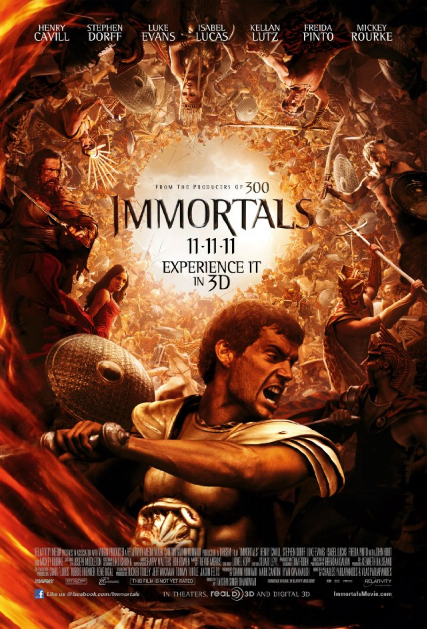Print Edition: November 23, 2011
 After the commercial failure of his passion project The Fall, a movie that was both visually astounding and narratively stultifying, Tarsem Singh has returned to the studio system with Immortals. While Immortals could be said to have its feet planted in Greek mythology, the story’s ancient qualities speak more to its pilfering of standard revenge and rise of the hero tales than its close relations to Plutarch, who, it should be noted, did not receive a story credit.
After the commercial failure of his passion project The Fall, a movie that was both visually astounding and narratively stultifying, Tarsem Singh has returned to the studio system with Immortals. While Immortals could be said to have its feet planted in Greek mythology, the story’s ancient qualities speak more to its pilfering of standard revenge and rise of the hero tales than its close relations to Plutarch, who, it should be noted, did not receive a story credit.
In Henry Cavill’s role as Theseus, he flaunts his considerable talents when it comes to showing off and stabbing foes, likely exceeding what he’ll be able to do in next year’s Superman. The script doesn’t really make him a hero, but the camera tries its hardest, and while Cavill isn’t given a lot to do (like almost everyone in the movie) besides strike poses that’ll look good on promotional materials, he does a slightly better job at playing the almost anti-hero status the movie foists upon him than most of the other off-the-assembly-line leading actors working in Hollywood today. The obligatory “stand and fight” battle speech is practically devoid of anything resembling sentences, but Cavill, aided by Tarsem, looks and acts the part. His character’s motivation is by the numbers, though his mentor needs to remind him that in addition to loved ones, he needs to protect the innocent and powerless too. This leads to a silly attempt to growl out a final monologue showing the error of the villain’s ways in a final, deadening battle. But the scene in particular that motivates him puts to shame a similarly-staged moment in another current hero movie of our time, and the believable (or unbelievable) fierceness of Cavill’s physique conveys more than any of the scripts lines are able to.
As in Tarsem’s other films, there is incredible attention paid and demanded of the visuals, but perhaps most surprisingly, the music video and advertisement icon has for the most part left his music video montages behind. While not every scene is expertly staged (a tunnel battle’s beginning is simply incoherent), Tarsem here holds his shots, taking in the expansive world that’s been created – yes, through CGI, but is no less entrancing than some of the natural worlds of The Fall. Perhaps because of the style of lighting, or maybe it is only because Immortals shares, if only slightly, a corner of the epic genre with more classic efforts when similar techniques were used, the CG matte backgrounds achieve a painterly quality that speaks better for the use of CG in blockbuster efforts than the majority of other works. Almost all incorporate it today, but Tarsem seems to work best in the studio system, understanding how to use technology to aid his vision, not encroach on it.
The violence in Immortals is the one aspect of the movie that could be said to accurately depict some element of the Greek epics. It is indulgent in that it’s slowed down to a self-proclaimed rhythmic beauty. The final battle—which contrasts the gods’ apparent unquenchable thirst for blood via ballet and mortal brutality via oddly choreographed wrestling—is amusing in its attempts to top itself with every cut back to the immortal action. But tracking shots of Theseus’ ability to eviscerate, and the slow reveal of violence in the first half of picture—which is surprisingly story heavy, and equally surprisingly not dull for a Tarsem movie—are the heart of Tarsem’s skills as a filmmaker.
Immortals lacks the visual wit of the best kind of blockbusters, like Paul W.S. Anderson’s The Three Musketeers, despite considerable attempts to enlighten the mood via Mickey Rourke’s ham-eating performance. And it is occasionally ugly, as in an unnecessary women-in-refrigerator moment. A tacked-on love story and an odd statement by one of the gods that “we must let them choose of their own free will” are likewise misguided. And finally, it features the most loathed and unnecessary of trends in Hollywood movies: the set up for a sequel scene. But Tarsem Singh’s spastic golden toys are at all times deadly serious and sometimes awe-inspiring in their splendour. Watching Immortals, one gets the sense that Tarsem thinks and wants you to think he’s crafting some of the most beautiful images of all time. He’s dead wrong, but it’s fun to watch him try.

